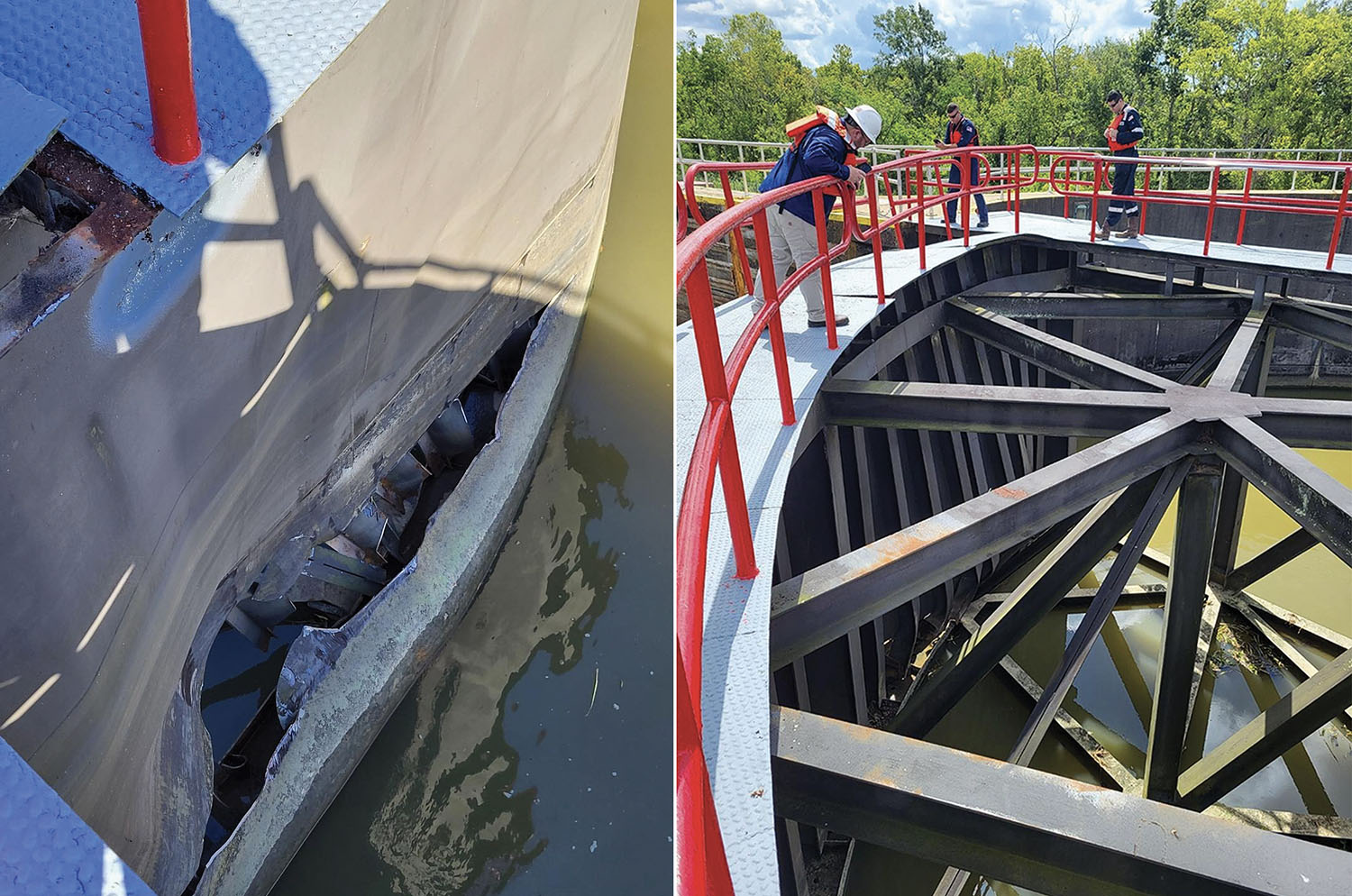About 6 p.m. on July 4, a towing vessel pushing a loaded barge entered Algiers Lock in New Orleans from the Mississippi River, bound for the Gulf Intracoastal Waterway (GIWW), when it allided with the lock’s canal-end sector gates.
While the impact only put a dent in the north-side sector gate, the south-side sector gate sustained major damage.
“It pierced the skin and damaged the structural steel frame of the gate,” said Victor Landry, operations project manager for the New Orleans Engineer District’s GIWW structures.
According to Landry, the towboat captain reported to the Algiers lockmaster that a surge of water from the wake of a passing ship pushed the tow into the gate.
Landry said the gash in the sector gate is about 10 feet wide and only a couple of feet above the water line. Corps officials do not know whether the gate sustained damage below the water line.
After the incident, the New Orleans District continued locking vessels through the night, with the district conducting a thorough damage assessment at first light July 5.
“The gates are swinging, and they’re not making noise,” Landry said. “With low water conditions, we’re able to operate the locks, swing the gates and keep moving traffic.”
Landry said the location and size of the hole, though, will require repairs to be made prior to the close of the current low-water season. In higher river levels, the puncture could cause turbidity in the chamber due to water escaping, which could endanger vessels transiting the lock, Landry said. Pushing the closure back to late summer or early fall should still avoid higher river conditions, while also giving industry time to plan.
“What I’m looking at, since we can swing the gates, is a planned closure in the ballpark of mid-September,” Landry said.
There are no spare sector gates for Algiers Lock; thus the chamber will have to be partially dewatered, with the gates repaired in place. Landry estimated the closure will last between 45 and 60 days. The district is currently seeking emergency funds to execute the repairs.
“Luckily, we do have our manpower available locally to address this in that September-to-October timeframe,” Landry said.
Landry said he’s well aware of the constraints low water is currently placing on access between the western GIWW and the Mississippi River. As in 2022, the Lower Mississippi River is at an extremely low stage, with the Carrollton Gage in uptown New Orleans fluctuating between 1.5 feet and 3.5 feet. Low water has forced the closure of Harvey Lock, the only other New Orleans-area lock connecting the western GIWW to the Mississippi River. Farther upriver, daytime closures are ongoing at Bayou Sorrel Lock, part of the GIWW’s Port Allen Alternate Route.
Landry hopes the Mississippi River will have edged up just enough by September or October to allow for Harvey Lock to be open during the closure at Algiers.
“The big thing is we want to get Harvey open,” Landry said. “I don’t want to shut Algiers with Harvey closed.”
Having Harvey Lock available will also ease navigation constraints if the Coast Guard were to order an evacuation of the New Orleans regulated navigation area (RNA) ahead of a hurricane or tropical storm. A closure at Algiers this summer or fall would coincide with hurricane season.
In balancing the timing of the closure, its duration and operating the lock between now and then, Landry said the focus is maintaining safe navigation for the maritime industry.
“Anything we can do to minimize system impacts is what we want to do,” he said. “And we’d like to minimize impacts to an RNA evacuation, so the further we can push it back, the less potential impact it will have in case of a hurricane evacuation.”
Even in normal operating conditions, tripping tows through Harvey, rather than Algiers, will be a challenge for local operators due to the sheer volume of barges crossing the Mississippi River on the GIWW. Still, industry leaders say they are up to the task.
“The prospect of Algiers Lock being out of commission for several weeks this fall will be challenging,” said Todd Clower, CEO of Harbor Towing, who also serves as chair of AWO’s southern region and as a board member of the Gulf Intracoastal Canal Association. “Our industry is resilient, and we will face and overcome this challenge as we have done with similar challenges in the past. I am confident in Vic Landry’s leadership and believe that the Corps of Engineers will move as quickly as possible to restore normal operations.”
Caption for top photos (click on image for full size): Photos show damage to the Algiers Lock canal-end sector gates caused by a tow allision on July 4. The New Orleans Engineer District said the lock is still operable; the Corps plans to schedule a closure for early fall to repair the damage. (Photos courtesy of New Orleans Engineer District)




